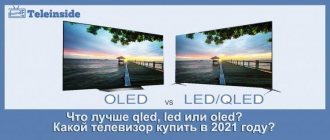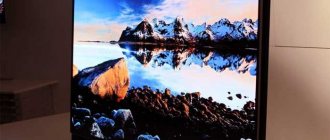Almost a century has passed since the invention of television. Since then, technology has come a long way and the means of transmitting moving images have undergone dramatic changes. Viewers had the opportunity to fully enjoy a realistic picture, full-size, bright, color and contrast. This is largely the merit of Samsung, whose engineers invented and patented QLED technology. From this article you will learn what it is, how it is implemented and what features it has.
Quantum dots have been known to science for more than a quarter of a century. They are crystals of semiconductor material smaller than 1/10,000 of a human hair. They are photoactive, that is, when exposed to light radiation or electrical energy, they begin to emit their own light in red, blue and green. What color the dot will re-emit depends on its size. For example, a quantum dot with a core 2 nanometers in diameter will emit blue, and 6 nm will emit red.
Scientists all over the world have worked to put this phenomenon at the service of humanity, but for the first time, only the employees of the Samsung Research Center succeeded in creating a TV screen powered by quantum dots. The technology was patented and called QLED. This is an English abbreviation of the phrase quantum dot, which means “quantum dot”.
A bit of QLED history
In the early nineties of the last century, scientific work began on the study of quantum dots as a light source, and in the 2000s they began to be considered as the basis for creating a new generation of displays. The Lenxington QD Vision laboratory was created specifically for these purposes. Independent scientists, representatives of LG and Samsung worked together in it. The latter presented a pilot sample of a QLED display in the winter of 2011. It was a four-inch screen, created in two variations: glass and polymer. Both were controlled by an active matrix.
Initially, cadmium was used to produce quantum dots on an industrial scale. The material is very expensive, toxic and limited in the weight of a homogeneous element, so Samsung Electronics specialists began to look for a replacement for it. It became indium, which since 2015 has been purchased from Dow Chemical (partner and exclusive supplier of Samsung, LG and a number of other companies).
Advantages of nanocrystals over OLED
Here everything is not so obvious. QLED displays have two obvious advantages: long service life and rich color range. Organic LEDs burn out over time, so they are inferior to crystals in durability. When it comes to brightness, QLED is the undisputed leader, regardless of which technology is compared.
As for other important technical characteristics: viewing angle, response time, black level, contrast, much will depend on which particular model we are talking about. Many OLED TVs are absolutely not inferior to more expensive analogues according to these criteria. Some critics even believe that the use of quantum dots is an attempt to reincarnate old ideas. Therefore, they treat it as an advertising gimmick.
What is QLED technology?
QLED is a technology for the production of liquid crystal screens with Quantum dot LED backlight on an industrial scale. The rights to it belong to Samsung, but all participants of the QLED-Alliance, which was created in the spring of 2021, can use the name for commercial purposes. It consists of using strips of luminous crystals as a base. By lithographic application, the strips are attached to a matrix of thin-film transistors. Their use makes it possible to create each pixel of the matrix with three subpixels: blue, green and red.
When combined with different intensities, they create millions of shades, which allows you to achieve stunning image quality. The technology makes it possible to create subpixels measuring 10*50 microns, which makes it possible to use QLED matrices not only in television screens and computer monitors, but also in icetops and smartphones.
What is Quantum Dot?
The full name of the technology is Quantum Dot Enhancement Film - this is how the use of quantum dots in televisions is designated. This technology uses a blue LED, and quantum dots act as a light filter, providing green and red transmission.
A quantum dot is a semiconductor. This is a microscopic crystal that is powered by a blue LED. TVs created using this technology are labeled QLED. The size of a quantum dot directly depends on what color will be transmitted.
QLED matrix device
In quantum dot monitors, blue LEDs are key. Used as the main backlight. They generate a light flux that passes through a transparent layer of a special substance with quantum dots inside. This is how green and red colors of the highest possible purity are added to the spectrum. The Samsung QLED matrix consists of the following elements:
- LED lights;
- transparent film with quantum dot;
- polarizer;
- glass substrate;
- liquid crystal cells;
- light filter.
The polarizer and glass substrate are duplicated in the design. Between the diodes located over the entire screen area and the matrix there is a sheet of phosphor. It creates a full-color glow behind the screen and provides the widest possible color gamut.
Operating principle
Initially, the developers wanted to take the OLED matrix and modernize it. They planned to use quantum dots as an emissive layer. But the main goal of the scientists was to create a full-fledged TV running on Quantum dot, so they abandoned the original idea, choosing photoluminescent technology. Currently, electroemission displays exist only in the form of test samples. Liquid crystal screens with photoluminescent quantum dots as backlight are produced on an industrial scale.
They are controlled by an active TFT martium consisting of thin-film transistors (thickness from 1/10 to 1/100 microns). The use of quantum dot for the production of color displays has made it possible to reduce the cost of matrices, ensure color rendition of liquid crystal screens as close as possible to natural, reduce power consumption by five times compared to LCD variations, and significantly increase the operating life of devices.
Color rendition
The QLED matrix creates a wide color gamut with more than ninety percent coverage of the DCI-P3 color space. This allows you to display the brightest and most saturated colors, which are particularly realistic. All benefits can be fully appreciated when viewing HDR content. In terms of brightness and color saturation, QLED matrices are significantly ahead of OLED and LED counterparts. Realism of the image and good perception of brightness are key features. Anti-reflective interference coatings (used on all top Samsung models) allow you to enjoy viewing in any lighting intensity.
Black level, brightness and contrast
These are key parameters for a modern TV. QLED models predominantly use VA panels, which can provide significantly higher black levels than the same IPS variations.
Typical QLED panel contrast values reach 4000:1 and higher, black levels range from 0.016 to 0.020 nits with an average brightness of 1400-2000 nits and its peak values reaching 4000 nits. Added to this is local dimming, which allows black levels to be achieved close to maximum depth. The contrast and black depth parameters of a TV with an IPS matrix are on average four times lower than those of QLED models.
Motion Blur
This effect appears due to the slow action of the pixels, which lag behind in the formation of the picture. Their response time is a key parameter that affects the smoothness of image processing.
Film QLED matrices are distinguished by their ability to control the rapid change of pixel color. They show minimal response time, significantly surpassing their analogues in this indicator. Only top OLED models can react faster to color changes. Both varieties show minimal or no blur in dynamically changing images.
Ultra Black Technology
This is the development of the South Korean brand Samsung. The technology ensures the absorption of light glare. As a result, you can enjoy watching TV even when sunlight hits the TV screen. Again, many experts were skeptical about this innovation. The essence of the technology comes down to the use of matte screens, but this solution was also used in the past to combat glare.
The non-uniform structure of the matte display really helps absorb glare. Glossy displays reflect light, making viewing difficult. The uneven matte structure refracts the light flux, preventing reflection.
OLED vs QLED: Which is Better – It's the Difference that Makes the Difference
When it comes to modern screens, two acronyms usually come to mind. This is natural, because they are the ones who largely determine the market now. Samsung Electronics was at the origins of both technologies. This is also why they have a lot in common, but are still significantly different.
In TV production, the corporation's management has shifted its emphasis towards QLED matrices. They became the next stage in the evolution of the familiar liquid crystal screens. OLED panels also integrate organic light-emitting diodes. They emit light of a certain spectrum without third-party influence, which leads to the preservation of a residual image. This is their key difference between the two top varieties.
Advantages and disadvantages of qled
QLED TV is distinguished by outstanding technical characteristics and excellent performance.
Here are their key advantages:
- Extreme image clarity. Supports AI Upscaling, HDR (including multivariations), 4K and 8K resolutions.
- Increased viewing angle. This is achieved by using two additional quantum dot layers.
- Realism of the image. Due to phenomenal brightness and excellent color rendition.
- Complete absence of burnout. Such TVs are designed to operate continuously for a long time at any brightness. The manufacturer provides a ten-year guarantee against burnout.
- Innovative anti-reflective coating. Not subject to abrasion, increases contrast, does not attract dust.
- The ability of the screen to display a static image. QLED TV in Ambient mode can duplicate a wallpaper pattern, display a view from a window, a photo reproduction or a work of art with a minimum of energy consumption.
Such screens compare favorably with analogues in terms of picture quality, supported technologies and formats, and performance characteristics. One could call them ideal, if not for one “But”.
This is due to the following disadvantages:
- Price. For many, this is the determining factor. QLED models are on average almost three times more expensive than trivial LED analogues with the same screen diagonal.
- Lack of opportunity to open up fully. QLED TV was somewhat ahead of its time. Nowadays, most video content is shot in Full HD format, and quantum dot TVs realize their potential when displaying images in 4K and 8K.
- Just a flat screen. Despite the fact that toxic cadmium, which required insulation, was eliminated from the design, quantum dot panels are not flexible. Curved screens are a trend that has every chance of becoming a long-term trend.
- Pixel burnout - but now even this is guaranteed
For most users, the disadvantages are insignificant and are more than compensated by the advantages.
Is it worth buying a QLED TV?
Which TV to choose?
So far, the mass purchase of such TV equipment is hampered by high prices, and this disadvantage of q led ensures that this type of TV is chosen only among enthusiasts of HDR content with Full HD (1920×1080 pixels), which is not yet sufficiently developed in our country.
An additional argument for buying this generation of TVs will be that while manufacturers of OLED equipment promise to reduce their high prices, manufacturers of TVs with qLED screens are actually reducing these prices by 10-15% from year to year. And we should not forget about the unprecedented power and clarity of sound provided by the Dolby Vision system, unprecedented for receivers in this range.
Instead of conclusions
If you want to fully enjoy bright, contrasty and realistic images in 4K and 8K formats, you won't find a more suitable option for this than a QLED matrix. It is a recognized leader in this segment; in terms of brightness and color rendition, there is no worthy alternative. Excellent performance and cool options such as Ambient mode are no less compelling arguments in favor of this choice. Yes, there are some problems with pixel burn-in, but this is solvable and will be fixed in the near future. It should be understood that you have to pay for quality. If your budget is limited and you plan to watch FULL HD quality video content, it makes sense to consider simpler and cheaper analogues.
Who will win
The main parameters of all types of display matrices have been reviewed, which means it’s time to answer the most important question - which technology will provide the best quality, and which TV is worth buying? If your budget allows, then give preference to a model with an OLED matrix.
However, if you want to choose a TV with the optimal price/quality ratio, or you are interested in a specific parameter (brightness, color reproduction), then the new 4K TV device from Samsung will look like a preferable option.
If we talk about ordinary 4K LED TVs with HDR support, of which there are much more in electronics supermarkets, then they will also cope with the reproduction of ordinary media content.
It's still an LCD TV
The wide color gamut will be especially useful for new 4K TVs and 4:4:4 color subsampling, which awaits us in future standards. That's all well and good, but remember that quantum dots don't solve other problems with LCD TVs. For example, it is almost impossible to get perfect black, because liquid crystals (the same “blinds” that I wrote about above) are not able to completely block light. They can only “cover themselves”, but not close completely.
Quantum dots are designed to improve color reproduction, and this will significantly improve the impression of the picture. But this is not OLED technology or plasma, where the pixels are able to completely stop the flow of light. However, plasma TVs have retired and OLED TVs are still too expensive for most consumers, so it's still good to know that manufacturers will soon offer us a new kind of LED TV that will show better.
Minuses
Samsung's claim of “revolutionary” technology sounds beautiful and resonant, invoking a sense of product perfection. But that's not true. These are the disadvantages of the technology.
Price
In electronics production, they strive to reduce the number of parts and the size of existing ones. In quantum screens too: they do not have a metal nanofilter. But this did not make its cost less.
The cheapest 55-inch QLED TV costs 69 thousand . And LED with the same diagonal is 20-25. TVs with a diagonal of 65” are already 160 thousand rubles . The largest of them is already 1.5 million .
Direct screen only
When making a layer with quantum dots, cadmium is used, a toxic metal that releases dangerous compounds when in contact with air. For safety, the panel is closed in a special “vessel”.
In order not to break the tightness of the “vessel”, it should not be bent. Therefore, such TVs will not be able to simulate a 360-degree view. And in 2021, TVs with organic screens have such technology. Moreover, they can be rolled into a roll and it will slide out of a special drawer when it is turned on.
The content does not reveal the capabilities of the TV
Now 95% of directors, bloggers and those who produce video content make it in Full HD . But the TV starts to show its maximum at 4K and 8K.
A person needs a TV primarily to watch movies and news, and not to search for videos in “super-duper quality.”
How much does a “quantum TV” cost?
The first QD TVs from Sony, Samsung and LG are promised to be shown at CES 2015 in January. However, China's TLC Multimedia is ahead of the curve, they have already released a 4K QD TV and say it is about to hit stores in China.
55-inch QD TV from TCL, shown at IFA 2014
At the moment it is impossible to name the exact cost of TVs with the new technology; we are waiting for official statements. They wrote that QDs would cost three times less than OLEDs with similar functionality. In addition, the technology, as scientists say, is very inexpensive. Based on this, we can hope that Quantum Dot models will be widely available and simply replace conventional ones. However, I think that prices will still increase at first. As is usually the case with all new technologies.
Precision Black technology
Samsung Super Ultra HD TVs feature an extended dynamic range of brightness. This became possible thanks to the implementation of two technologies – Peak Illuminator and Precision Black. The first provides an increase in the brightness of the LED backlight in certain areas. Precision Black – local dimming technology. It allows you to achieve the broadcast of rich black color.











